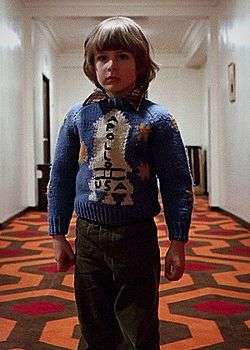Danny Torrance
 | |
| Danny Torrance | |
|---|---|
| Fictional appearances | |
| Books: |
|
| Film & TV: |
|
| Development information | |
| Creator: | Stephen King |
| Onscreen portrayals: |
|
Daniel Anthony "Danny" Torrance is a fictional character that first appears in the 1977 novel The Shining by Stephen King as a child with "the shining", meaning psychic powers. The character also appears in the 1980 film adaptation The Shining and was played by Danny Lloyd. The character also appears in the 1997 TV miniseries The Shining and was played by Courtland Mead. In 2013, Stephen King released the novel Doctor Sleep, a sequel to the 1977 novel that features an adult Danny Torrance as the protagonist.
Characterization
Danny Torrance in The Shining is one of several child characters in Stephen King's early fiction who deal with parental abandonment or the fear of it; other characters include Carrie White in Carrie and Charlene "Charlie" McGee in Firestarter.[1] Heidi Strengell, in Dissecting Stephen King, says, "In King's view children, like Danny Torrance, are able to deal with fantasy and terror on their own terms better than adults because of the size of their imaginative capacity and their unique position in life."[2] The reference guide Characters in 20th-Century Literature wrote, "Some critics complain that Danny displays an improbable maturity for a child his age."[3] Author Dale Bailey, writing about haunted houses, said King's writing of Danny, a psychic in a haunted setting, borrowed the link made by Shirley Jackson and Richard Matheson in their works. Bailey perceives Danny as having ambivalence toward his father, being devoted but also learning psychically how emotionally disturbed his father is. The author said there was evidence of parallels between Danny and his father, "Danny, like Jack himself, may someday fall into behavioral patterns of the father he both loves and fears."[4]
In the novel The Shining, Danny shares his power of "the shining" with several strangers, where in the film adaptation, he is secretive about it, even when sharing with Dick Halloran. In the novel, Danny has an extraordinary intelligence, a large vocabulary, is attached to his father and is able to foresee all of Hotel Overlook's horrors. In contrast, in the film, he is portrayed as an ordinary boy with only the extraordinary power and has visions that change with events that happen at the hotel.[5] Academic Greg Jenkins says the primary reason for Danny being less talkative was the difficulty for a child actor to memorize lines, but he said the minimal dialogue also created more suspense.[6]
In the various appearances, Danny has an imaginary friend Tony, who is portrayed in different ways. The Dissolve said King portrayed Tony as "a part of Danny, a piece of future adult potential made manifest". In Kubrick's film, Tony is only imaginary, and the TV miniseries portrays Tony as an invisible presence to warn Danny of danger.[7] Bailey said of the incarnation of Tony in the original novel was "a projection of Danny's mind, giving voice to anxieties which otherwise transcend his understanding", citing as evidence the interlinking of the male Torrances' names: grandfather Mark Anthony Torrance, John Daniel "Jack" Torrance, and Daniel Anthony Torrance.[4]
Stephen King said he had been asked what happened to Danny Torrance after the events of The Shining, and he decided to write its sequel Doctor Sleep.[8] In the novel, Danny is depicted as an alcoholic drifter who is haunted by the memory of his father. The Guardian said of the portrayal of Danny, "It... captures the reality of a recovering alcoholic, a state with which King is intimately familiar." King said he wanted to depict Danny as avoiding being like his parents and trying to escape his roots.[9]
References
- ↑ Beahm, George (2015). The Stephen King Companion: Four Decades of Fear from the Master of Horror. St. Martin's Griffin. p. 5. ISBN 978-1-250-05412-8.
- ↑ Strengell, Heidi (2006). Dissecting Stephen King: From the Gothic to Literary Naturalism. Popular Press. p. 170. ISBN 978-0-299-20974-2.
- ↑ Howes, Kelly King (1995). Characters in 20th-Century Literature. Gale Research. p. 253. ISBN 978-0-8103-9203-8.
- 1 2 Bailey, Dale (2011). American Nightmares: The Haunted House Formula in American Popular Fiction. University of Wisconsin Press. pp. 92, 95. ISBN 978-0-299-26873-2.
- ↑ Rasmussen, Randy (2005). Stanley Kubrick: Seven Films Analyzed. McFarland. pp. 233–234. ISBN 978-0-7864-2152-7.
- ↑ Rhodes, Gary D. (2007). Stanley Kubrick: Essays on His Films and Legacy. McFarland. p. 140. ISBN 978-0-7864-3297-4.
- ↑ Robinson, Tasha (October 31, 2013). "What The Shining miniseries reveals about the King/Kubrick divide". The Dissolve. Retrieved October 7, 2015.
- ↑ Minzesheimer, Bob (September 18, 2013). "Stephen King finally reawakens Danny Torrance in 'Doctor Sleep'". USA Today. Retrieved September 30, 2015.
- ↑ Brockes, Emma (September 21, 2013). "Stephen King: on alcoholism and returning to the Shining". The Guardian. Retrieved September 30, 2015.